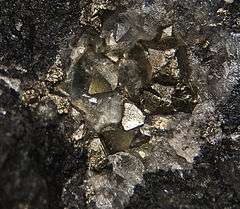Stannite
| Stannite | |
|---|---|
|
Stannite Fabulosa Mine, Larecaja Province, La Paz Department, Bolivia- 2 mm crystals | |
| General | |
| Category | Sulfide mineral |
| Formula (repeating unit) | Cu2FeSnS4 |
| Strunz classification | 2.CB.15a |
| Crystal system | Tetragonal |
| Crystal class |
Scalenohedral (42m) H-M symbol: (4 2m) |
| Space group | I42m |
| Unit cell | a = 5.4432, c = 10.7299 [Å]; Z = 2 |
| Identification | |
| Color | Steel-gray to iron-black, may tarnish blue |
| Crystal habit | Rarely as pseudo-octahedral crystals also massive, granular, and disseminated |
| Twinning | Penetration twins on {102} |
| Cleavage | Indistinct on {110} and {001} |
| Fracture | Uneven |
| Mohs scale hardness | 4 |
| Luster | Metallic |
| Streak | Black |
| Diaphaneity | Opaque |
| Specific gravity | 4.3 - 4.5 |
| References | [1][2][3] |
Stannite is a mineral, a sulfide of copper, iron, and tin. The chemical formula Cu2FeSnS4. Zinc commonly occurs with the iron and trace germanium may be present.[3] Stannite is used as an ore of tin, consisting of approximately 28% tin, 13% iron, 30% copper, 30% sulfur by mass. It is found in tin-bearing, hydrothermal vein deposits occurring with chalcopyrite, sphalerite, tetrahedrite, arsenopyrite, pyrite, cassiterite, and wolframite.[1] Also known as bell metal ore.
The name comes from the Latin for tin: stannum. It was first described in 1797 for an occurrence in Wheal Rock, St. Agnes, Cornwall, England.[3]
See also
References
- 1 2 http://rruff.geo.arizona.edu/doclib/hom/stannite.pdf Handbook of Mineralogy
- ↑ http://webmineral.com/data/Stannite.shtml Webmineral data
- 1 2 3 http://www.mindat.org/min-3747.html Mindat.org
This article is issued from Wikipedia - version of the 12/2/2016. The text is available under the Creative Commons Attribution/Share Alike but additional terms may apply for the media files.
